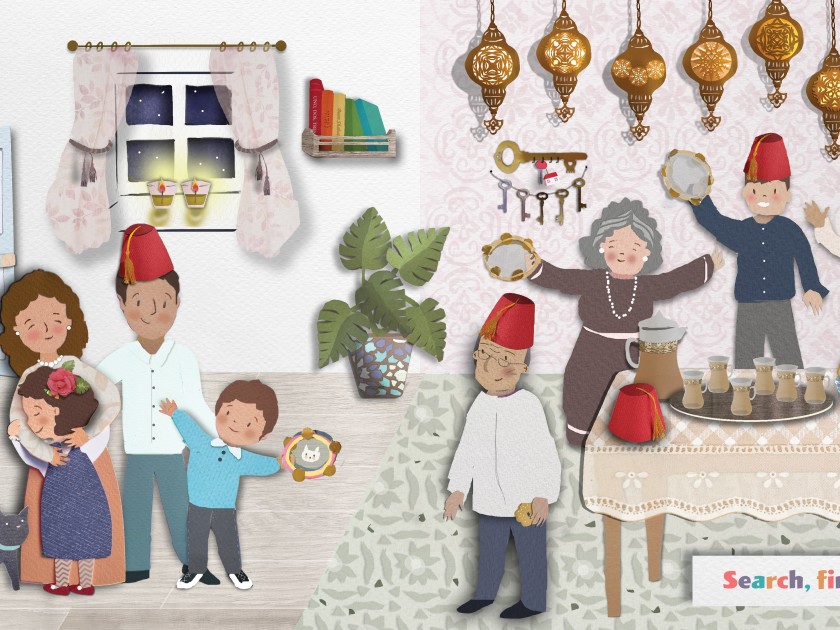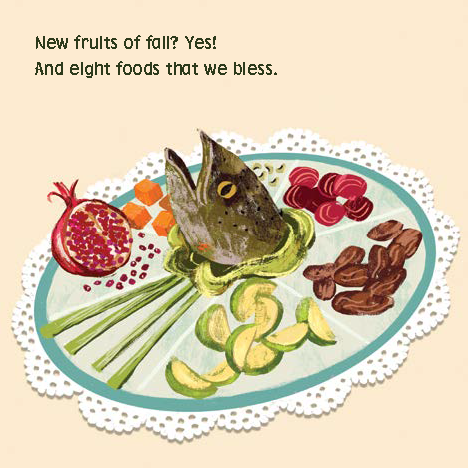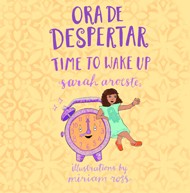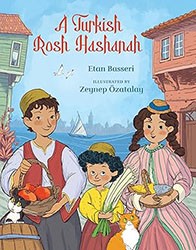
Illustration, cropped, from Uno Dos Tres, written by Sarah Aroeste and illustrated by Nathalie Belhassen, provided courtesy of PJ Publishing, an imprint of PJ Library ®, and the Harold Grinspoon Foundation.
When we think of bilingualism, we most often think of language — the fluency to convey the same idea in multiple languages. Ask any parent, we all see being bilingual as an asset for our children in today’s globalized world. What I wouldn’t give for my own children to wake up one day having mastered Mandarin, Spanish, Arabic, and Hebrew, let alone English.
But is being bilingual limited to language?
As a picture book writer, I inevitably think about the illustrations that match the words I use. As a Jewish picture book author, I spend a lot of time thinking about how — given the medium’s limited word count — Jewish symbols complement the prose.
There are, of course, common and universal Jewish symbols, such as candles, that can stand in for Shabbat. But do all candles look alike? While many Ashkenazi households use wax candles, many Sephardim use oil. Or take challah, as another example. Must challah always look braided? Besides during the High Holidays, when challah is traditionally circular, many Jewish cultures enjoy rounded or other non-braided challah throughout the year. The same basic symbols can be visualized very differently. What does it look like to be bilingual in not just decoding languages, but also symbols?
In a counting board book I recently published, I picked ten symbols that, for me, represent my identity. Those items were:
- Hand
- Candles
- Drums
- Hats
- Books
- Cups
- Keys
- Lamps
- Cookies
- Flowers
By themselves, those words might convey certain images in your head. But in different contexts the words can take on different meanings. What happens when you think of the symbols through a specifically Jewish lens? For example, what type of hat comes to mind now for the fourth symbol — A kippah? A shtreimel? A baseball cap?
The name of the book for which I chose the symbols is Uno Dos Tres: A Sephardic Counting Book. Does knowing it’s a Sephardic book, with numbers in Ladino, change how you view the symbols now? You might not automatically think of a fez when you see the word “hat,” but I’m hoping through my books that, one day, you — and your children — might. Here’s a look at how I paired the words above with the specific Sephardic symbols I wanted to convey:
- Hand: A hamsa, the five-fingered hand shape that is a traditional symbol of peace and protection that originated in the middle east
- Candles: Wicks floating in oil
- Drums: Skinned tambourines, often used in festive Sephardic music
- Hats: Fezes, the traditional Ottoman head covering
- Books: Those with titles in Ladino (did you know that Sephardic Jews introduced the printing press to the Jewish world?)
- Cups: Fashioned in ornate Turkish glass, common in Sephardic households
- Keys: Shaped in the old skeleton style, a reminder of the homes Sephardic families left behind in Spain when they were exiled
- Lamps: Intricate and colorful glass mosaics, fixtures that hang in many Sephardic homes
- Cookies: The iconic Sephardic biskocho
- Flowers: Roses, a favorite ingredient in Sephardic cuisine
The book’s final spread shows the symbols as a collection. Taken all together, I want these symbols to create a visual landscape for the readers of any age to reimagine these seemingly common words (hand! hat! cup!) in new, bilingual ways.

Illustration from Uno Dos Tres, written by Sarah Aroeste and illustrated by Nathalie Belhassen, provided courtesy of PJ Publishing, an imprint of PJ Library ®, and the Harold Grinspoon Foundation.
The symbols I chose in Uno Dos Tres are clear examples, but even in some of my other books, (including my recently published, Anyada Buena, Shanah Tovah) I show bilingualism beyond the book’s Ladino and Hebrew title, in the images and text itself.
Blessing new foods for the fall is a Rosh Hashanah custom that many Jews across the globe practice. And in Anyada Buena, Shanah Tovah, an image of a seder plate is paired with my prose: “New fruits of fall? Yes! And eight foods that we bless.” While the prose doesn’t say the word “seder,” the symbol of the loaded plate is there to convey it.

Illustration from Anyada Buena, Shanah Tovah written by Sarah Aroeste and illustrated by Maria Mola, provided courtesy of Kar-Ben Publishing.
A seder for Rosh Hashanah? Indeed! Many Sephardic and Mizrachi Jews have a special seder ceremony to bless specific foods that are bestowed with special significance for the new year. Pairing the symbol of a seder plate with words about Rosh Hashanah (not Passover!) establishes a bilingual way of reading what a seder plate can represent. With minimal words and symbols, we can add and change layers of meaning.
I believe that creating bilingual picture books is an important way we can teach families about the breadth of Jewish life. As a Sephardic children’s book author, the use of Ladino words and language concepts are central to my work. Beyond language, however, I place equal import on how I want to convey symbolic bilingualism.
If you’re a parent, ask your kids: “What are the ten symbols you would choose together to represent your family?” For added fun, try drawing them, too!
In the same way that I dream of my children having fluency in Hebrew one day, I also want them to have facility in reading Jewish symbols in multiple ways. How can we help our children become more bilingual – and feel the Jewish pride that comes with that? Reading a variety of Jewish children’s books, ones that reflect our own cultural traditions and those of others, is a great way to start.
Sarah Aroeste is an award-winning singer-songwriter and children’s book author focused on bringing Sephardic culture to new generations. She has published numerous bilingual Ladino/English books for children such as Buen Shabat, Shabbat Shalom and Mazal Bueno! Her forthcoming book with PJ Publishing, Bavajadas! That’s Just Silly! will be released Fall 2025. Visit saraharoeste.com for more.



